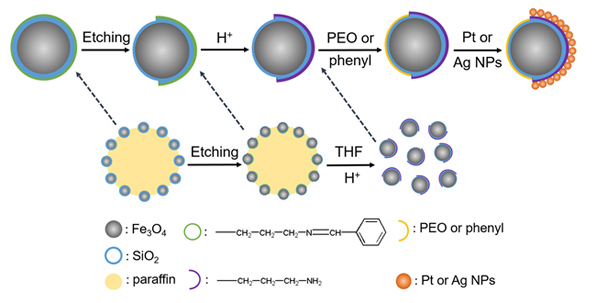[1] De Gennes, P. G. Rev. Mod. Phys. 1992, 64, 645.
[2] Jiang, S.; Granick, S. Janus Particles Synthesis, Self-assembly and Applications, RSC, London, England, 2012.
[3] Shi, S. Y.; Zhang, L. L.; Zhang, G. L.; Song, X. M.; Sun, D. Y.; Liang, F. X.; Yang, Z. Z. Macromolecules 2020, 53, 2228.
[4] Xiang, D.; Jiang, B. Y.; Liang, F. X.; Yan, L. T.; Yang, Z. Z. Macromolecules 2020, 53, 1063.
[5] Zhang, H.; Wang, Q.; Jiang, B. Y.; Liang, F. X.; Yang, Z. Z. ACS Appl. Mater. Interfaces 2016, 8, 33250.
[6] Zhao, R. T.; Yu, X. T.; Sun, D. Y.; Huang, L. Y.; Liang, F. X.; Liu, Z. P. ACS Appl. Nano. Mater. 2019, 2, 2127.
[7] Zhao, R. T.; Han, T. H.; Sun, D. Y.; Huang, L. Y.; Liang, F. X.; Liu, Z. P. Langmuir 2019, 35, 11435.
[8] Nisisako, T.; Torii, T.; Takahashi, T.; Takizawa, Y. Adv. Mater. 2006, 18, 1152.
[9] Hays, D. A. J. Electrost. 2001, 51-52, 57.
[10] Wu, B.; Liu, Z. Q.; Liu, X. S.; Liu, G. Q.; Tang, P.; Yuan, W.; Fu, G. L. Nanotechnology 2020, 31, 225301.
[11] Dolbashian1, C.; Chavez1, B. L.; Bauer, M.; Budi, M.; Andrew, J. S.; Crawford, T. M. J. Phys. D:Appl. Phys. 2020, 53, 195002.
[12] Li, L. L.; Bacaksiz, C.; Nakhaee, M.; Pentcheva, R.; Peeters, F. M.; Yagmurcukardes, M. Phys. Rev. B 2020, 101, 134102.
[13] Paulus, M.; Degen, P.; Brenner, T.; Tiemeyer, S.; Struth, B.; Tolan, M.; Rehage, H. Langmuir 2010, 26, 15945.
[14] Xu, Q. A.; Kang, X. W.; Bogomolni, R. A.; Chen, S. W. Langmuir 2010, 26, 14923.
[15] Ozin, G. A.; Manners, I.; Fournier-Bidoz, S.; Arsenault, A. Adv. Mater. 2005, 17, 3011.
[16] Wang, J. ACS Nano 2009, 3, 4.
[17] Cui, L. Y.; Fan, S. S.; Yu, C. L. Acta Chim. Sinica 2017, 75, 967(in Chinese). (崔丽影, 范莎莎, 于存龙, 化学学报, 2017, 75, 967.)
[18] Zhang, B. B.; Ma, C.; Wang, X. G. Acta Chim. Sinica 2015, 73, 441(in Chinese). (张贝贝, 马驰, 王小刚, 化学学报, 2015, 73, 441.)
[19] Chen, C. Y.; Yi, J. Q.; Dong, H. Y. Chin. J. Chem. 2015, 33, 527.
[20] Liang, F. X.; Yang, Z. Z. Acta Polym. Sin. 2017, (6), 883(in Chinese). (梁福鑫, 杨振忠, 高分子学报, 2017, (6), 883.)
[21] Tang, L.; Liang, F. X.; Wang, Q. Chin. J. Polym. Sci. 2017, 35, 799(in Chinese). (唐琳, 梁福鑫, 王倩, 高分子科学, 2017, 35, 799.)
[22] Meng, H. Y.; Wan, J. P.; Jing, J. Y. Chin. Chem. Lett. 2020, 31, 253(in Chinese). (孟宏宇, 万基平, 井静云, 中国化学快报, 2020, 31, 253.)
[23] Jing, J. Y.; Yao, X. H.; Yang, Z. Z. Acta Polym. Sin. 2018, 8, 1066(in Chinese). (井静云, 姚晓辉, 杨振忠, 高分子学报, 2018, 8, 1066.)
[24] Liang, F. X.; Liu, B.; Yang, Z. Z. Polym. Bull. 2016, (9), 45(in Chinese). (梁福鑫, 刘冰, 杨振忠, 高分子通报, 2016, (9), 45.)
[25] Pickering, S. U. J. Am. Chem. Soc. 1907, 91, 2001.
[26] Binks, B. P. Curr. Opin. Colloid Interface Sci. 2002, 7, 21.
[27] Lin, Y.; Skaff, H.; Emrick, T.; Dinsmore, A. D.; Russell, T. P. Science 2003, 299, 226.
[28] Melle, S.; Lask, M.; Fuller, G. G. Langmuir 2005, 21, 2158.
[29] Komazaki, Y.; Hirama, H.; Torii, T. J. Appl. Phys. 2015, 117, 154506.
[30] Binks, B. P.; Lumsdon, S. O. Langmuir 2000, 16, 2539.
[31] Liang, F. X.; Zhang, C. L.; Yang, Z. Z. Adv. Mater. 2014, 26, 6944.
[32] Kline, T. R.; Paxton, W. F.; Mallouk, T. E.; Sen, A. Angew. Chem., Int. Ed. 2005, 44, 744.
[33] Laocharoensuk, R.; Burdick, J.; Wang, J. ACS Nano 2008, 2, 1069.
[34] Wang, J.; Manesh, K. M. Small 2010, 6, 338.
[35] Gao, W.; Uygun, A.; Wang, J. J. Am. Chem. Soc. 2012, 134, 897.
[36] Jonathan, R. H.; Richard, A. L. J.; Anthony, J. R.; Tim, G.; Reza, V.; Ramin, G. Phys. Rev. Lett. 2007, 99, 048102-1.
[37] Ge, Y. E.; Wang, T.; Zheng, M. F.; Jiang, Z. Z.; Wang, S. Nanotechnology 2019, 30, 315702.
[38] Zheng, J.; Wang, J. G.; Xiong, Z.; Wan, Z. H.; Zhan, X. J.; Yang, S. J.; Chen, J. W.; Dai, J.; Tang, J. Y. Adv. Funct. Mater. 2019, 29, 1901768.
[39] Xuan, M. J.; Wu, Z. G.; Shao, J. X.; Dai, L. R.; Si, T. Y.; He, Q. J. Am. Chem. Soc. 2016, 138, 6492.
[40] Wu, Y. J.; Wu, Z. G.; Lin, X. K.; He, Q.; Li, J. B. ACS Nano 2012, 6, 10910.
[41] Crossley, S.; Faria, J.; Shen, M.; Resasco, D. E. Science 2010, 327, 68.
[42] Kirillova, A.; Schliebe, C.; Stoychev, G.; Jakob, A.; Lang, H.; Synytska, A. ACS Appl. Mater. Interfaces 2015, 7, 21218.
[43] Wang, C.; Yin, H.; Dai, S.; Sun, S. Chem. Mater. 2010, 22, 3277.
[44] Valadares, L. F.; Tao, Y. G.; Zacharia, N. S.; Kitaev, V.; Galembeck, F.; Kapral, R.; Ozin, G. A. Small 2010, 6, 565.
[45] Liu, Y. J.; Hu, J. K.; Yu, X. T.; Xu, X. Y.; Gao, Y.; Li, H. M.; Liang, F. X. J. Colloid Interface Sci. 2017, 490, 357.
[46] Xu, X. Q.; Deng, C. H.; Gao, M. X.; Yu, W. J.; Yang, P. Y.; Zhang, X. M. Adv. Mater. 2006, 18, 3289. |
